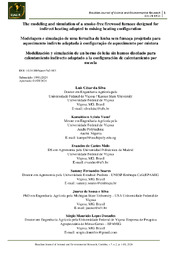The modeling and simulation of a smoke-free firewood furnace designed for indirect heating adapted to mixing heating configuration.
The modeling and simulation of a smoke-free firewood furnace designed for indirect heating adapted to mixing heating configuration.
Author(s): SILVA, L. C. da; YUSUF, K. A.; MELO, E. de C.; SOARES, S. F.; SILVA, J. de S. e; DONZELES, S. M. L.; VITOR, D. G.
Summary: ABSTRACT: The use of wood furnaces for thermal energy applications in drying is common among coffee growers in Brazil. However, incomplete combustion of firewood and excessive use of damaged furnaces can lead to product contamination and negative environmental effects. To address this issue, a smoke-free wood furnace was designed, to heatthe drying air utilizing aheat exchanger,andusing a removable smoke-free combustion cell. The new furnace design was based on thermal energy ranging from 15 to 30 kW, drying airflow rates from 35 to 45 m³ min-1, and drying air temperatures from 50 to 80 °C. The design process considered the thermal energy required for heating air, furnace fuel consumption, combustion chamber volume, grate area, and heat exchanger dimensions. The performance of the adapted furnace data was monitored over time using a graphics statisticalcontrol (x-bar chart). Regression analysis of temperature and mass flow rate for the mixed heating configurations was carried out to develop quadratic models for the modified operation.The models were used to create a simulation model using ExtendTM simulation language to predict the performance of the furnace, in mixed heating at the desired drying air temperature. The simulation was carried out under two different conditions, normal and controlled operation of the furnace. Five scenarios of working hours without refueling (119 min) drying temperature were carried out. The simulation result indicates that the furnace operates at a maximum efficiency of approximately 40% irrespective of the desired drying temperature during normal operation. However, controlled operation with increased opening time of the mixing air inlet for admitting ambient air into the mixing chamber significantly improved the furnace's efficiency, with an optimum efficiency of 55% achieved at 90°C drying temperature. The simulation reflects that the furnace operates at a maximum efficiency of 68% at a temperature of 90°C, which can be attained at 66.31 minutes of operation in mixed heating of 30 minutes and indirect heating configuration of 89 min during working hours without refueling of 119 min.
Publication year: 2024
Types of publication: Journal article
Unit: Embrapa Coffee
Keywords: Combustion, Eucalyptus, Furnaces, Regression analysis, Temperature, Thermal energy
Observation
Some of Embrapa's publications are published as ePub files. To read them, use or download one of the following free software options to your computer or mobile device. Android: Google Play Books; IOS: iBooks; Windows and Linux: Calibre.
Access other publications
Access the Agricultural Research Database (BDPA) to consult Embrapa's full library collection and records.
Visit Embrapa Bookstore to purchase books and other publications sold by Embrapa.

